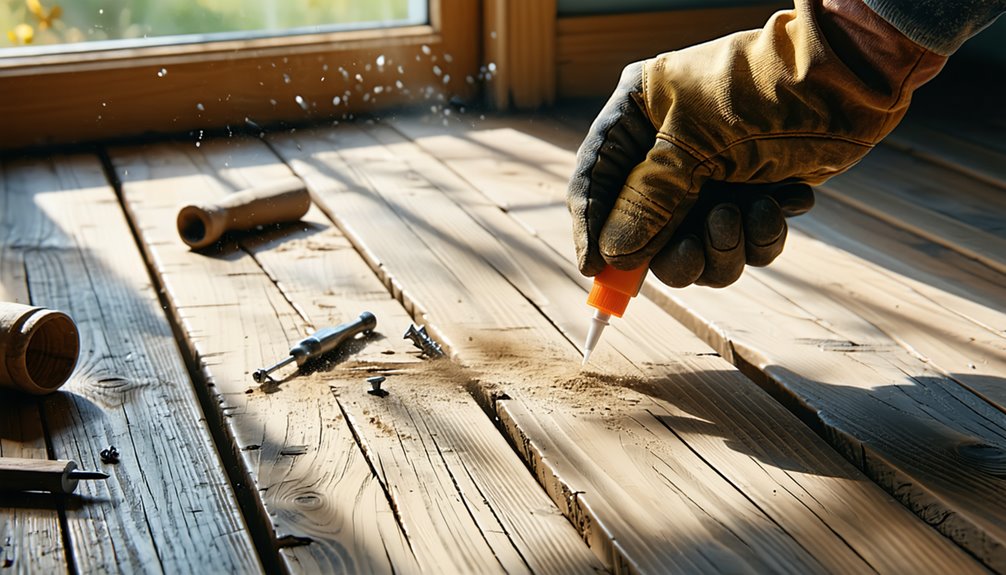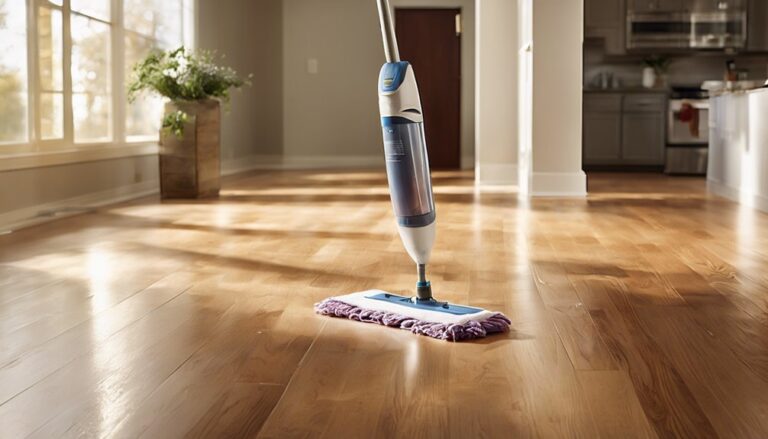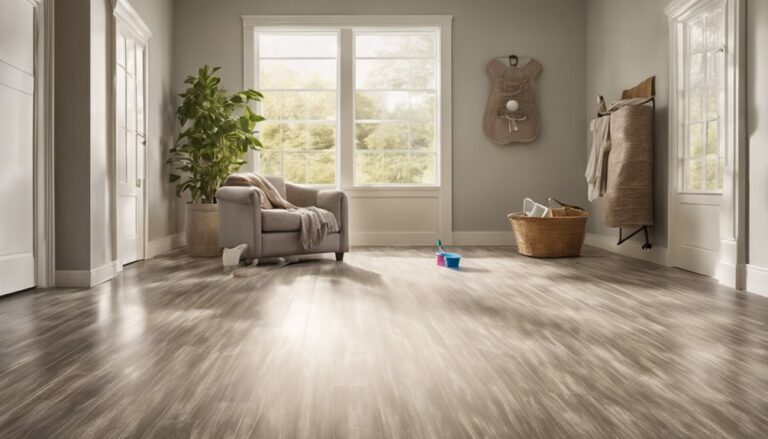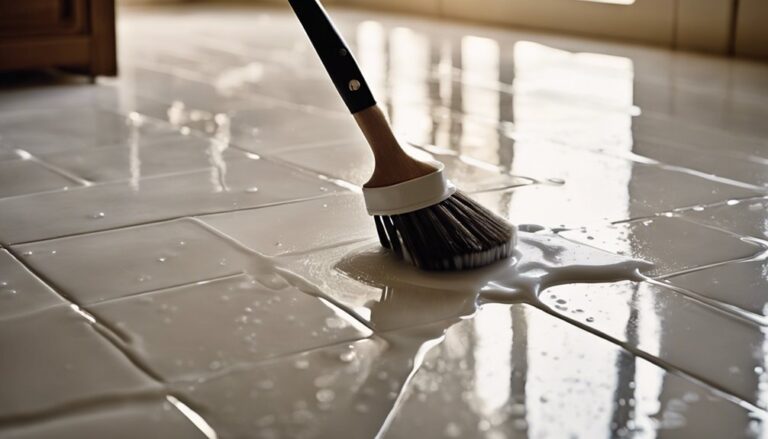Para reparar pisos que rechinan, comience por identificar los puntos ruidosos durante una inspección minuciosa. Recorra los pisos, escuche si crujen y marque las áreas problemáticas. Apriete las tablas sueltas con tornillos y considere usar cuñas para rellenar los huecos entre las vigas y las tablas para mayor estabilidad. Si los clavos están flojos, golpéelos suavemente para colocarlos en su lugar o reemplácelos por otros más gruesos para un mejor agarre. Lubrique las áreas que rechinan con polvo de grafito o silicona en aerosol para reducir la fricción. Con un poco de esfuerzo, restaurará la tranquilidad en su hogar, y aún hay más opciones para explorar soluciones a largo plazo.
Entendiendo los pisos chirriantes
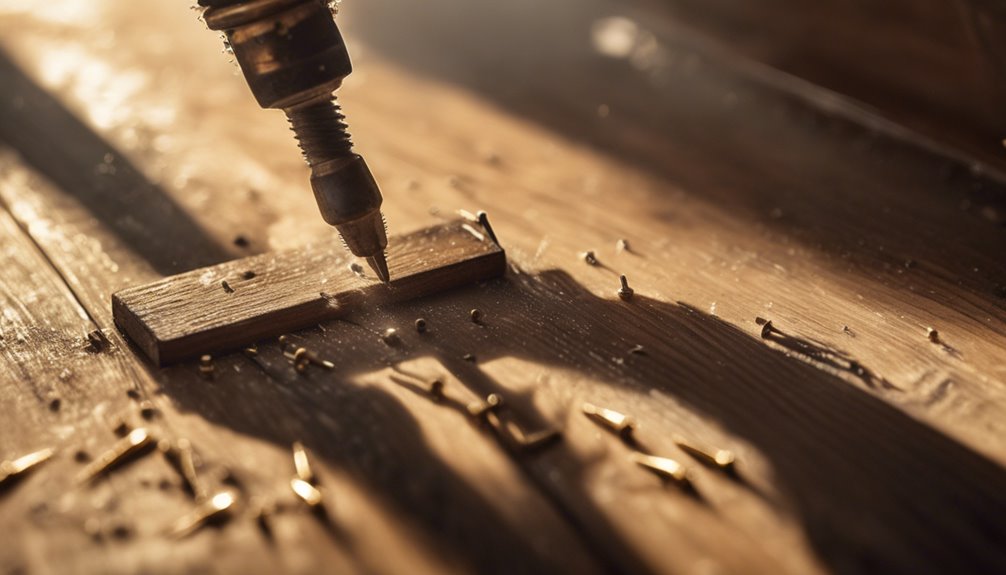
¿Alguna vez te has preguntado por qué rechinan tus pisos? Esos molestos sonidos suelen provenir de tablas sueltas o desalineadas. Al caminar sobre ellas, la fricción entre las tablas y los clavos, o las vigas que se encuentran debajo, crea ese temido crujido. Es importante entender que las tablas que rechinan pueden perturbar tu tranquilidad, pero también indican que un poco de mantenimiento puede ser de gran ayuda. Para reducir el ruido, considera examinar las áreas donde el sonido es más frecuente. Soluciones sencillas como apretar tornillos o colocar cuñas a menudo pueden mitigar el ruido. Al abordar estos chirridos a tiempo, no solo recuperas tu espacio tranquilo, sino que también prolongas la vida útil de tu piso. piso, dándole la libertad de disfrutar de su hogar sin interrupciones constantes.
Causas comunes de chirridos
Los chirridos en los pisos a menudo se deben a varias causas comunes. Una de las principales es el movimiento de la madera, que se produce con los cambios en los niveles de humedad. Cuando la madera absorbe humedad, se expande; al secarse, se contrae. Este movimiento constante puede generar espacios entre las tablas del piso y la estructura subyacente, lo que provoca esos molestos chirridos.
Los problemas de humedad también pueden deberse a una ventilación inadecuada o a fugas, lo que agrava el problema. Además, las tablas del suelo sueltas o los clavos sueltos pueden generar fricción y ruido al caminar. Comprender estas causas le permitirá abordar el problema eficazmente, devolviendo la paz a su hogar y permitiéndole disfrutar de la libertad de un espacio tranquilo.
Herramientas que necesitarás
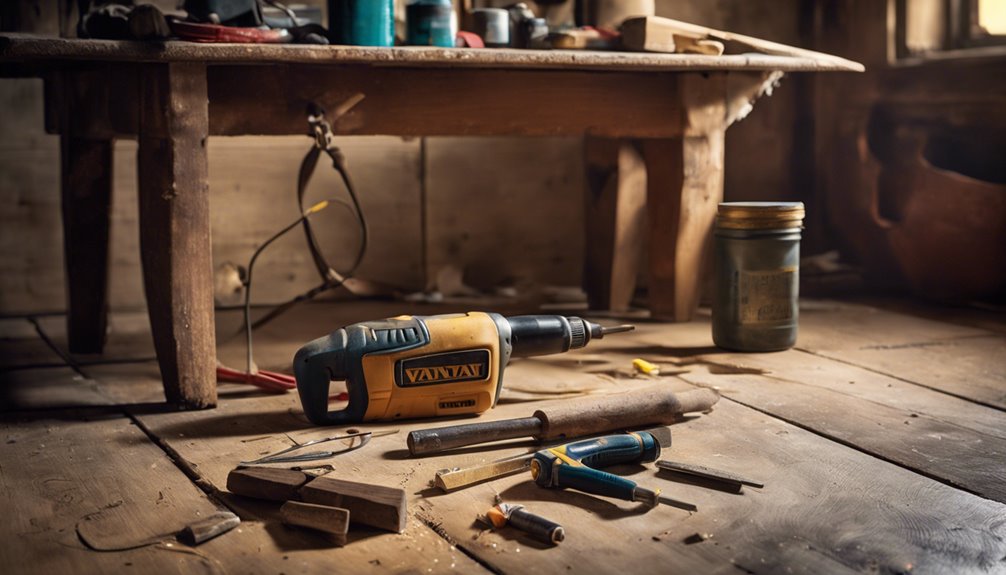
Antes de empezar a arreglar esos pisos que rechinan, necesitarás algunas herramientas esenciales para facilitar el trabajo. Un destornillador, pegamento para madera y un martillo son solo lo básico, pero no olvides revisar tu equipo de seguridad, como gafas protectoras y rodilleras, para mantenerte protegido. Tener las herramientas adecuadas a mano te ayudará a abordar el proyecto de forma eficiente y segura.
Herramientas esenciales necesarias
Al reparar pisos que rechinan, es fundamental tener las herramientas adecuadas a mano. Empieza con un destornillador, ya que lo necesitarás para apretar o cambiar los tornillos de las tablas que rechinan. Un martillo también puede ser útil para golpear suavemente las tablas sueltas. Considera usar pegamento para madera si encuentras huecos donde se mueven. Un detector de vigas es fundamental para localizar las vigas y asegurar un anclaje correcto. No olvides un nivel para mantener todo nivelado y una cinta métrica para obtener medidas precisas. Por último, unos alicates pueden ayudarte a sujetar y girar los tornillos más difíciles. Con estas herramientas para reparar pisos, estarás bien equipado para silenciar esos molestos chirridos y recuperar tu espacio.
Lista de verificación del equipo de seguridad
Cuando esté listo para encargarse de esos pisos que rechinan, no olvide su seguridad. Asegurarse de contar con el equipo de seguridad adecuado no solo lo protege, sino que también facilita el proceso. Aquí tiene una lista rápida de los artículos esenciales que necesitará:
- Gafas de seguridad: proteja sus ojos del polvo y los residuos mientras trabaja.
- Protección auditiva: si utiliza herramientas eléctricas, los tapones o protectores auditivos protegerán sus oídos de los ruidos fuertes.
- Rodilleras: mantendrán sus rodillas cómodas y protegidas mientras se arrodilla sobre superficies duras.
Inspeccionando sus pisos
Para empezar a arreglar esos pisos que rechinan, debe inspeccionar cuidadosamente cada área para detectar ruidos. Preste mucha atención a dónde se producen los chirridos, ya que esto le ayudará a identificar los puntos problemáticos, y asegúrese de revisar las vigas del piso para detectar cualquier signo de daño o desprendimiento. Finalmente, revise el material del piso para determinar si contribuye al problema, asegurándose de comprender claramente con qué está trabajando.
Identificar áreas chirriantes
¿Cómo identificar esas molestas zonas de tu suelo que rechinan? Una detección eficaz de chirridos empieza con una inspección exhaustiva del suelo. Aquí te explicamos cómo hacerlo:
- Caminar por el sueloMuévete por las diferentes zonas del suelo, prestando atención a cualquier ruido. Prueba diferentes pesos y velocidades; a veces, un paso suave revela más que un pisotón fuerte.
- Escuche atentamenteConcéntrate en dónde el sonido es más fuerte. A veces, tus oídos te guían mejor que tus pies.
- Marcar los puntosUse tiza o cinta adhesiva para marcar las zonas con chirridos. Esto le ayudará a recordar dónde concentrar sus esfuerzos de reparación más adelante.
Revisar las vigas del piso
Revisar las vigas del piso es esencial para identificar la causa de esos molestos chirridos. Empiece por localizar las vigas debajo del piso, generalmente separadas entre 40 y 60 cm. Durante la inspección, busque señales de daños como grietas, deformaciones o conexiones sueltas. Estos problemas pueden comprometer la estructura del piso y generar más que solo ruido; también pueden afectar la seguridad. Si detecta vigas sueltas, considere asegurarlas con tornillos o colocar bloques entre ellas para mayor soporte. Además, revise si hay espacios entre las vigas y el contrapiso, ya que estos también pueden contribuir a los chirridos. Abordar los problemas de las vigas a tiempo puede restaurar la tranquilidad y la comodidad de su hogar, a la vez que previene mayores daños en el futuro.
Inspeccionar el material del piso
Mientras se revisan las vigas, es importante también inspeccionar el material del suelo, ya que puede ser un factor importante en esos molestos chirridos. Los diferentes tipos de suelo tienen distintos niveles de durabilidad, lo que puede afectar la forma en que el sonido se propaga por la casa. Tómese el tiempo para comprobar si hay tablas sueltas o zonas dañadas que puedan estar causando el ruido.
A continuación se presentan tres aspectos clave a tener en cuenta:
- Calidad del material:Asegúrese de que su piso esté hecho de materiales duraderos que puedan soportar el desgaste.
- Integridad de la instalación:Verifique que el piso esté instalado correctamente, ya que una instalación incorrecta puede provocar chirridos.
- Brechas de expansión:Verifique que haya suficiente espacio de expansión, especialmente en pisos de madera, para evitar movimiento y ruido.
Ajuste de las tablas del suelo

Si ha notado que sus pisos rechinan, apretar las tablas suele ser una solución sencilla. Empiece por identificar el tipo de material de las tablas que tiene: madera dura, laminado o madera contrachapada. En el caso de la madera dura, puede usar tornillos para asegurar las tablas sueltas. Simplemente taladre a través de la tabla hasta la viga inferior, asegurándose de no partir la madera. Si se trata de laminado, considere usar una técnica de apriete que incluya añadir cuñas o ajustar la base. Esto ayuda a reducir el movimiento. En ambos materiales, es posible que tenga que quitar zócalos o alfombras para acceder mejor a las tablas. Recuerde: la clave es asegurarlas firmemente sin dañar la integridad de su piso.
Adición de lubricación
Para silenciar eficazmente esos pisos que rechinan, lubricar es un paso clave que no debe omitir. Le recomendamos explorar las mejores opciones de lubricación y aprender las técnicas de aplicación correctas para garantizar resultados superiores. Además, comprender la frecuencia de lubricación ayudará a mantener sus pisos silenciosos por más tiempo.
Las mejores opciones de lubricación
¿Cuál es la mejor manera de solucionar esos molestos chirridos en sus pisos? Elegir las opciones de lubricación adecuadas es esencial para prevenirlos eficazmente. Aquí hay tres tipos de lubricación que pueden ayudar:
- Polvo de grafitoEste lubricante seco no atrae polvo ni suciedad, lo que lo hace ideal para espacios reducidos.
- Spray de silicona:Proporciona un acabado suave y funciona bien en diversas superficies sin dejar residuos pegajosos.
- WD-40:Esta opción versátil penetra profundamente, reduciendo la fricción y el ruido de manera efectiva.
Cada uno de estos tipos de lubricación tiene sus ventajas, así que tenga en cuenta los materiales específicos de su piso y el origen de los chirridos. Con la lubricación adecuada, disfrutará de pisos más silenciosos y mayor libertad en su hogar.
Técnicas de aplicación explicadas
Aplicar lubricante a pisos que rechinan requiere precisión y cuidado para garantizar los mejores resultados. Empiece por identificar el origen del chirrido; suele estar ubicado donde las tablas del piso se unen con las vigas. Use una jeringa o un aplicador pequeño para aplicar el lubricante elegido directamente en los huecos. Sea generoso, pero evite saturar demasiado para evitar ensuciar. Después de la aplicación, revise el área para comprobar si el lubricante previene los chirridos. Si el chirrido persiste, podría necesitar volver a aplicarlo o considerar un lubricante diferente. Asegúrese siempre de que el mantenimiento de su piso sea constante; las revisiones regulares pueden ayudarle a detectar problemas antes de que se agraven. Con estas técnicas, disfrutará de un hogar más silencioso y prolongará la vida útil de su piso. Recuerde, un poco de atención ayuda mucho a mantener su espacio.
Frecuencia de lubricación
Lubricar regularmente sus pisos chirriantes puede reducir significativamente el ruido y prolongar su vida útil. Para mantener sus pisos en óptimas condiciones, establezca una frecuencia de lubricación que se adapte a su estilo de vida. Considere el siguiente programa de mantenimiento:
- Inspeccionar trimestralmente:Compruebe cada tres meses si hay nuevos chirridos o signos de desgaste.
- Lubricar semestralmente:Aplique lubricante durante la primavera y el otoño para combatir los cambios estacionales que puedan afectar sus pisos.
- Abordar los problemas inmediatos:Si nota un aumento repentino en los chirridos, no espere: lubrique rápidamente para evitar daños mayores.
Uso de calzas para soporte
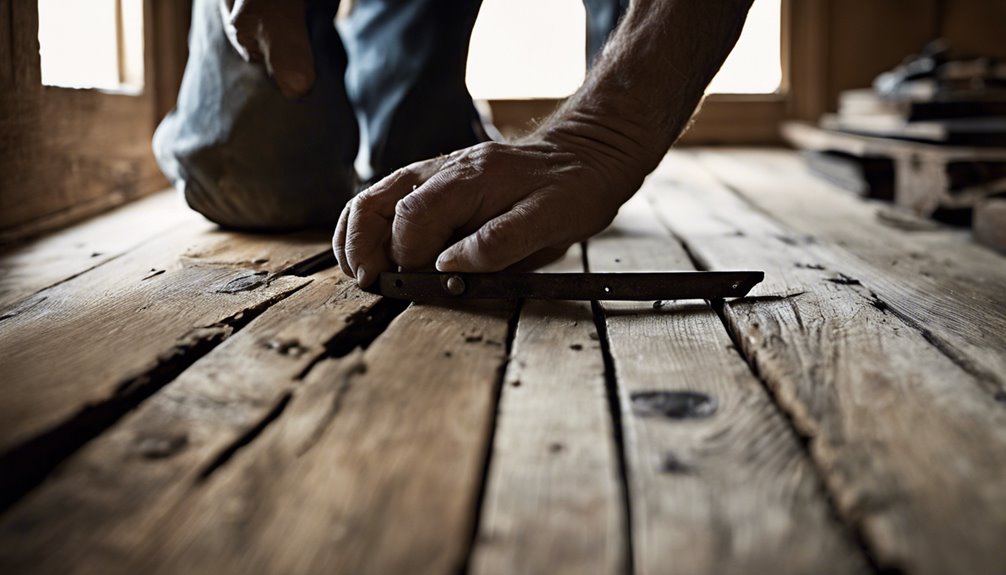
Si nota que sus pisos rechinan, un método eficaz para solucionar el problema es usar cuñas de soporte. La instalación de cuñas puede ayudar a rellenar los huecos entre las vigas y las tablas del piso, estabilizando los pisos y eliminando el ruido no deseado.
A continuación se ofrece una descripción general rápida de los materiales de calce que puede considerar:
| Tipo de material | Ventajas |
|---|---|
| Madera | Asequible, fácil de cortar. |
| Plástico | Resistente a la humedad, duradero. |
| Metal | Fuerte y duradero |
Para instalar las cuñas correctamente, localice las zonas que chirrían, levante con cuidado las tablas del suelo e inserte las cuñas hasta que queden ajustadas. Este método no solo silencia el ruido, sino que también mejora la integridad general del suelo, brindándole el ambiente tranquilo que desea.
Reparación de uñas sueltas
Una forma eficaz de solucionar los chirridos en los suelos es reparar los clavos sueltos. Cuando notes esos molestos chirridos, suele deberse a que los clavos se han desprendido del suelo. Aquí te explicamos cómo solucionarlo:
- Identificar los tipos de uñasDetermine si se trata de clavos de acabado, clavos para pisos u otros tipos. Cada uno requiere un manejo diferente.
- Elige tus herramientas:Tome un martillo, un juego de clavos y posiblemente un poco de pegamento para madera para mayor seguridad.
- Vuelva a asegurar los clavosGolpee suavemente los clavos sueltos para colocarlos en su lugar, asegurándose de que queden al ras de la superficie. Si están demasiado sueltos, puede reemplazarlos por clavos más gruesos para un mejor agarre.
¡Disfrutarás de la paz y tranquilidad una vez que esos chirridos desaparezcan!
Soluciones para suelos radiantes

Aunque los pisos que rechinan a menudo se pueden solucionar arreglando los problemas visibles, a veces los verdaderos culpables se esconden bajo la superficie. Para solucionar estos problemas ocultos, considere mejorar el aislamiento del suelo. Esto no solo mejora las técnicas de insonorización, sino que también mejora la eficiencia energética. Comience por levantar las tablas del suelo en las zonas afectadas para evaluar el estado del aislamiento. Si es deficiente o está dañado, sustitúyalo por materiales de alta calidad diseñados para la absorción acústica. Además, usar sellador acústico en los bordes puede minimizar aún más la transmisión del ruido. Si se siente aventurero, incluso podría considerar la instalación de sistemas de canales resilientes, que separan el suelo de las vigas, reduciendo drásticamente los chirridos. Estas soluciones para el suelo pueden proporcionar un ambiente más tranquilo a la vez que mantienen sus pisos en buen estado.
Cómo prevenir futuros chirridos
Para mantener sus pisos silenciosos a largo plazo, es importante tomar medidas proactivas durante la instalación y el mantenimiento. Centrarse en la prevención de chirridos puede ahorrarle futuros dolores de cabeza. Aquí tiene tres consejos prácticos para garantizar que sus pisos permanezcan silenciosos:
- Utilice materiales de calidadInvierta en pisos y bases resistentes y de alta calidad que resistan el desgaste y el movimiento.
- Instalación adecuadaAsegúrese de que su piso esté instalado correctamente, con sujetadores y espaciado apropiados para minimizar el movimiento.
- Mantenimiento regular de pisos:Revise periódicamente si hay tablas sueltas y repárelas inmediatamente para evitar que se produzcan chirridos.
Preguntas frecuentes
¿Puedo reparar pisos que rechinan sin quitar la alfombra?
Sí, puede reparar pisos que rechinan sin quitar la alfombra. Empiece por identificar las causas, que suelen deberse a tablas o clavos sueltos. Una técnica práctica de reparación es espolvorear talco o grafito entre las tablas para reducir la fricción. Como alternativa, puede usar una aguja para alfombras para inyectar pegamento para madera en los huecos. Estos métodos le permiten evitar los molestos chirridos y proteger su alfombra.
¿Cuánto tiempo suele durar una reparación de piso?
Imagina que acabas de arreglar un suelo que rechinaba tras años de molestias. Probablemente te preguntes cuánto durará esa reparación. Normalmente, una reparación de suelo puede durar varios años, dependiendo de los materiales utilizados y del estado de tu casa. Para maximizar la vida útil de la reparación, considera consejos de mantenimiento como revisar regularmente si hay tablas sueltas y aplicar lubricante donde sea necesario. Ser proactivo ayudará a mantener tus suelos silenciosos y tu espacio agradable por más tiempo.
¿Existen servicios profesionales para reparaciones de pisos chirriantes?
Por supuesto, existen opciones profesionales para reparar pisos que rechinan. Si busca soluciones efectivas para pisos que rechinan, contratar expertos puede ahorrarle tiempo y garantizar una reparación de alta calidad. Los profesionales evalúan su situación específica, utilizando técnicas como reforzar las vigas o aplicar lubricantes, adaptadas a su tipo de piso. Cuentan con las herramientas y la experiencia necesarias para abordar el problema eficazmente, permitiéndole disfrutar de su espacio sin la distracción de ruidos molestos que interrumpan su libertad.
¿Reparar pisos que rechinan dañará mi piso?
Arreglar pisos que rechinan es como afinar un instrumento musical: puede crear armonía en su hogar sin causar daños. Si lo hace correctamente, no dañará su piso. Comprender las causas del rechinamiento, como tablas sueltas o un soporte inadecuado, es esencial para prevenir daños. Con las técnicas adecuadas, puede silenciar esos molestos crujidos y preservar la integridad de sus pisos. Así que no se preocupe; ¡puede lograr paz en su hogar!
¿Puede la humedad afectar los pisos chirriantes?
Sí, la humedad puede afectar los pisos chirriantes. Cuando la humedad aumenta, ciertos materiales como la madera pueden expandirse, creando espacios que causan chirridos. Por el contrario, la baja humedad puede hacer que la madera se encoja, lo que también puede generar ruido. Si experimenta chirridos en sus pisos, considere los efectos de la humedad en su entorno. Mantener un nivel de humedad equilibrado puede ayudar a minimizar estos problemas, permitiéndole disfrutar de un hogar más tranquilo y confortable sin molestias constantes.

